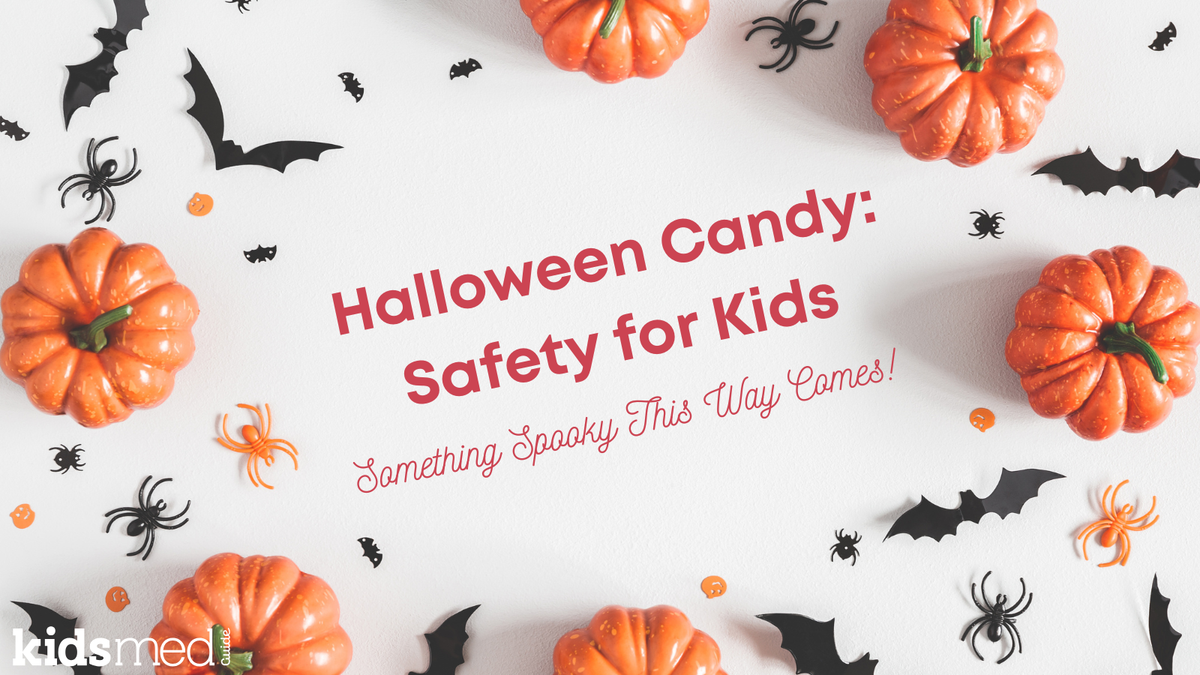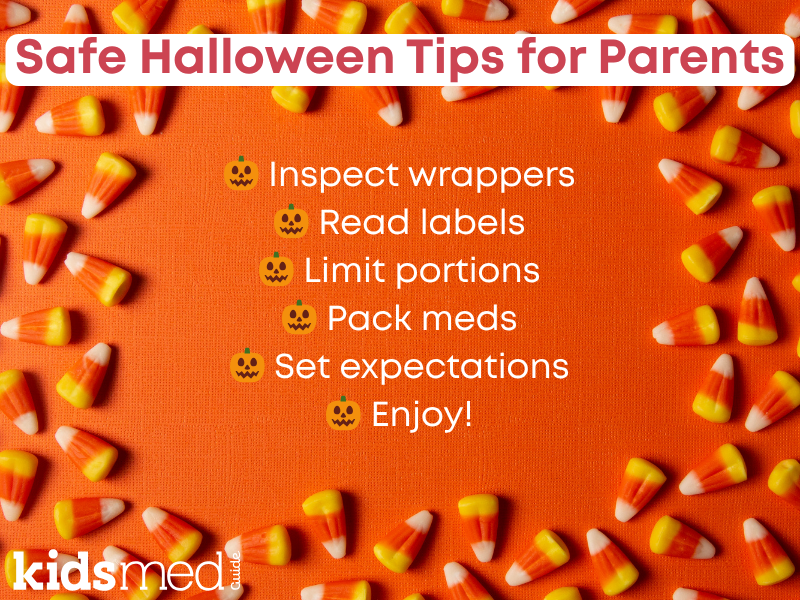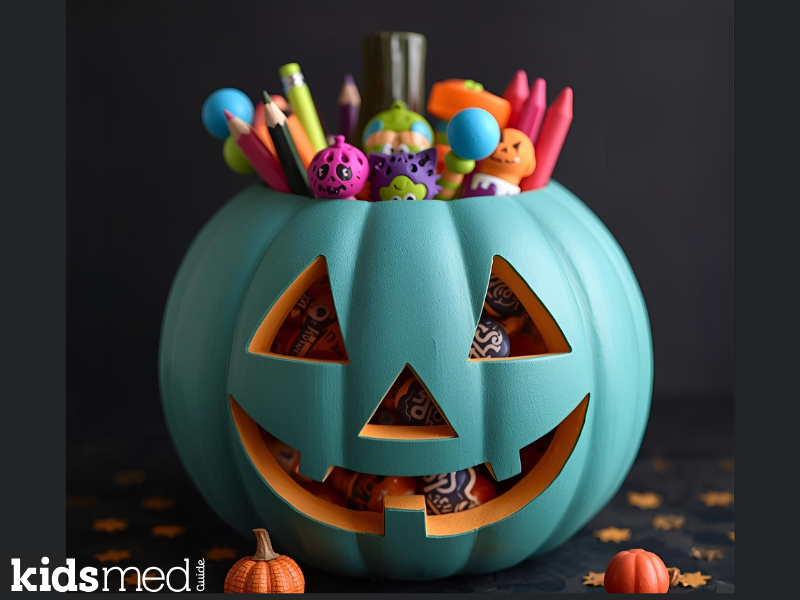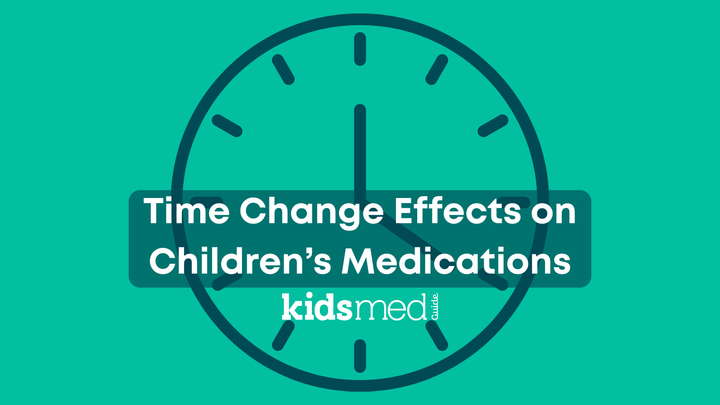Halloween Candy: Safety for Children

Halloween is one of my favorite holidays! Our neighborhood has lots of kids, and we have a blast trick-or-treating. I also have a mean sweet tooth, so I thoroughly enjoy confiscating some of my kids' candy – you know, for safety!
As much as I enjoy sneaking candy, I dislike how Halloween has turned into a month-long binge of junk food. My kids are prone to cavities, so all that extra sugar isn’t good for their teeth. Or their overall behavior.
For families managing allergies, diabetes, or other special diets, all the celebrations and trick-or-treating can become even more challenging to enjoy! Halloween candy safety for children is a real concern that some parents have to address. This guide covers common worries and ideas to keep the holiday fun and safe!
Understanding the Risks of Halloween Candy
Halloween is all about fun, and it should be! Enjoy the costumes, classroom parties, and spookiness of it all. It’s also a time when food safety needs extra attention. The mix of unknown ingredients, unlabeled treats, and excess sugar can lead to frightening surprises. (Get it?)
From a safety standpoint, here’s what to watch for:
- Allergens: Many candies contain common allergens like peanuts, milk, soy, or gluten, and even small traces can cause reactions. Cross-contact can happen easily in manufacturing, especially with “mini” candy sizes that may lack full labels or be found in mixed bags.
- Choking hazards: Hard candies, small gummies, and gum can be risky for younger children.
- Blood sugar spikes: For children with diabetes or metabolic conditions, large amounts of sugar can lead to unpredictable highs and lows.
Safe Halloween Candy Tips for Parents
Parents can do a lot to reduce the risks without totally taking away the fun. These Halloween food safety tips for parents help keep kids safe while still letting them enjoy their treats:
1. Inspect candy before eating it, and don’t let your kids munch on treats while trick-or-treating. Once home, check for torn wrappers, holes, or signs of tampering. When in doubt, toss it!
2. Read ingredient labels carefully. Watch for allergens, artificial dyes, and sugar alcohols (which can upset stomachs). In the case of severe allergies, remember that many mini-sized candies come from mixed bags, and cross-contamination is possible.
3. Avoid unlabeled or homemade treats from neighbors unless you know the ingredients and trust the neighbors. Teach your kids to say “no thanks!” politely.
4. Use portion control. The AAP and Academy of Nutrition and Dietetics recommend limiting candy to small portions after meals — pairing all that excess sugar with protein and fiber from dinner can help stabilize blood sugar.
5. Keep emergency supplies nearby. For kids with allergies or diabetes, bring your child’s medications (like an epinephrine auto-injector, diabetic supplies, or glucose tabs) when you’re out. Make sure you have refills available and your medication and supplies are in date before the big night.

Allergen-Free and Special Candy Options
Thankfully, parents have more choices than ever for allergen-free Halloween candy and specialty sweets. Many brands now clearly label for allergens or make certified allergy-friendly products.
Some trusted brands to consider:
- Enjoy Life (free from the top 14 allergens)
- No Whey! Foods
- YumEarth (organic and dye-free)
- Free2b (nut-free chocolate cups)
You can also encourage your neighborhood to join the Teal Pumpkin Project, an initiative by FARE (Food Allergy Research & Education) that promotes offering safe, non-food treats for kids with allergies.
Families managing diabetes can look for sugar-free candies made with ingredients like stevia or monk fruit, but keep in mind that sugar alcohols can still affect digestion and cause other unwanted side effects like GI upset. Children with diabetes can often enjoy Halloween candy safely if eaten in moderation, with parent supervision and careful blood sugar monitoring.
Every child with diabetes is unique, and individual management plans differ. Talk to your child’s pediatrician or diabetes care team to make sure you and your child are comfortable with your treatment and know how to handle blood sugar emergencies.
Non-Food Halloween Treats
Toys and trinkets can be just as good as candy! It’s amazing how excited kids get over small toys. Non-food Halloween treats are a fun option for families managing allergies, diabetes, or other conditions that limit sugar. Keep some in stock for your own kids, or pass it out to neighborhood friends.
Some non-food Halloween treat alternatives include:
- Stickers or temporary tattoos
- Mini bubble wands
- Glow bracelets or rings
- Snap bracelets
- Themed pencils or erasers
- Halloween coloring sheets or small crafts
- Keychains
- Mini slinkies, yo-yos, or other fidget toys
Beware of choking hazards from small toys and candy for babies and toddlers.
Lots of these non-candy treats can be bought at the dollar store or in bulk with retailers like Amazon, Target, or Oriental Trading Company. They might even be cheaper than overpriced Halloween candy, and kids will find them way cooler than something like a baggie of healthy snacks or a toothbrush.

Managing Candy at Home
Once the trick-or-treat bags are full, it’s all about candy management. This is a sensitive topic in my house. I’m unfortunately raising candy fiends (they must get it from their dad).
Here are some strategies that might help. (Having goals to aim for is usually a good thing, right?)
- Set daily limits. Have your child choose a few pieces each day to enjoy after meals.
- Keep candy out of reach. It helps prevent the temptation of "just one more." Ideally, store it somewhere Mom and Dad can't easily reach, too!
- Incorporate healthier snacks. Offer fruit, cheese sticks, yogurt, milk, or nuts alongside a piece of candy to balance sugar intake with fiber and protein-rich options.
- Create a candy checklist. For children with allergies, keep track of which brands and types are safe. It may help to write a clear and simple “yes” and “no” list for your child with allergies to avoid temptation before, during, and after trick-or-treating!
- Think about letting your child choose their top 5, 10, 20, or 50 items (you decide what amount you’re comfortable with) to enjoy in the days and weeks after Halloween, and donate the rest. Nursing homes, charities, homeless shelters, food pantries, and military troops are organizations you could consider donating to, and your child might be excited to do it!
Some families use the “Switch Witch” or a similar fairy, who takes most of the children’s Halloween candy overnight but leaves a cool toy, book, or prize in its place. Candy donation and swapping for a toy work best if you set the expectation well before Halloween. It’s hard to convince a child staring at a pile of candy with glazed eyes to give some up. It’s like if an adult had a pile of money!

Conclusion
Halloween is a fun holiday and can be a core memory for kids! If parents keep a Halloween candy safety plan in the back of their minds, kids can focus on having fun first. Check labels, have allergen-free Halloween candy and treats available, and stock up on some non-food Halloween treats for your kids and neighbors. There are many ways to enjoy the holiday! Boo! :-)
Frequently Asked Questions
How can I ensure Halloween candy is safe for my child with allergies?
Always read ingredient labels and avoid candy without clear packaging. Choose trusted brands with allergy-safe certifications and bring an epinephrine auto-injector if prescribed. Be aware of cross-contamination risks with Halloween candy, as small pieces from different companies and brands are often packaged or stored together.
What are some allergen-free Halloween candy options?
Try Enjoy Life, Free2b, or YumEarth, and others offer nut-free, gluten-free, and dairy-free choices. Always read the package label.
Are non-food Halloween treats a good alternative?
Absolutely! Stickers, toys, tattoos, fidget items, bubbles, crayons, pencils, trinkets, and glow sticks are fun and inclusive options that every child can enjoy. Be cautious of choking hazards for young toddlers and babies.
How can I limit candy intake without ruining the fun?
Plan a candy “swap” system — let kids trade extra treats for small prizes or toys, or get them excited about donating to a group or cause in need. It keeps things lighthearted and teaches moderation.
What is the Teal Pumpkin Project, and how does it help?
It’s a nationwide effort by FARE to support children with food allergies by offering non-food treats. Display a teal pumpkin to show your home participates.
The following references were used to compile this information:
7 Ways to Make Halloween Safer for Kids with Food Allergies. (n.d.). Retrieved October 15, 2025, from https://www.eatright.org/health/health-conditions/allergies-and-intolerances/7-ways-to-make-halloween-safer-for-kids-with-food-allergies
Avoid a Food Allergy Scare on Halloween. (2025, October 3). HealthyChildren.Org. https://www.healthychildren.org/English/health-issues/injuries-emergencies/Pages/Avoid-Food-Allergy-Scare-on-Halloween.aspx
Halloween and Diabetes | ADA. (n.d.). Retrieved October 15, 2025, from https://diabetes.org/food-nutrition/navigating-halloween-child-diabetes
Halloween Fun & Safety Tips for Kids of All Ages. (2025, October 14). HealthyChildren.Org. https://www.healthychildren.org/English/safety-prevention/all-around/Pages/Halloween-Safety-Tips.aspx?gad_source=1&gad_campaignid=69654055&gbraid=0AAAAADyMpZGU7Znj25GHKpdzhO5UPJWhJ&gclid=Cj0KCQjwjL3HBhCgARIsAPUg7a7jbPiVlNbagJ-viVbEZEkMmRdqPHxC4CmSBIvlNzwdCkbDKHxFZFkaAk7jEALw_wcB
McKeon, A. (2021, October 29). Halloween candy and dental care aren’t a trick. Boston Children’s Answers. https://answers.childrenshospital.org/cavities-are-no-trick-how-to-balance-halloween-candy-with-healthy-teeth/
Program, H. F. (2024). Halloween Food Safety Tips for Parents. FDA. https://www.fda.gov/food/buy-store-serve-safe-food/halloween-food-safety-tips-parents
Teal Pumpkin Project—FoodAllergy.org. (n.d.). Retrieved October 15, 2025, from https://www.foodallergy.org/our-initiatives/awareness-campaigns/teal-pumpkin-project.



